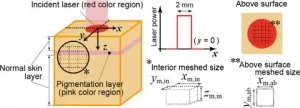Analysis of the sensitivity of the UK (B.1.1.7) and South African (B.1.351) variants to SARS-CoV-2
2021-03-29
(Press-News.org) The B.1.1.7 and B.1.351 variants of SARS-CoV-2 were first detected in the UK and South Africa respectively, and have since spread to many other countries. Scientists from the Institut Pasteur joined forces with Orléans Regional Hospital, Tours University Hospital, Créteil Intercommunal Hospital, Strasbourg University Hospital and Georges Pompidou European Hospital to study the sensitivity of these two variants to neutralizing antibodies present in the serum samples of people who have been vaccinated or previously infected with SARS-CoV-2. They compared this sensitivity with that of the reference virus (D614G), which was until recently the most widespread strain in France. The scientists demonstrated that the UK variant is neutralized to the same degree as D614G, whereas the South African variant is less sensitive to neutralizing antibodies. To neutralize the South African variant, the antibody concentrations need to be six times higher than for D614G. This difference in sensitivity was also observed in vaccinated individuals; the antibodies in their serum are effective against the UK variant but less so against the South African one. The study was published in Nature Medicine on March 26th, 2021.
On December 14, 2020, the UK authorities informed WHO that a variant (B.1.1.7) had been detected in the south east of England. Within a few weeks, this variant took over from the viral strains circulating in this region and in London. On December 18, 2020, the South African authorities reported that a variant (B.1.351) had been detected and was spreading rapidly throughout three provinces of South Africa. According to WHO's epidemiological bulletin dated February 14, the UK and South African variants are now present in 94 and 48 countries respectively. These two variants are considered to be 'variants of interest' and are subject to epidemiological surveillance at national and international levels.
In a new study, scientists from the Institut Pasteur joined forces with Orléans Regional Hospital, Tours University Hospital, Créteil Intercommunal Hospital, Strasbourg University Hospital and Georges Pompidou European Hospital to study the sensitivity of the UK and South African variants to antibodies in comparison with the reference strain circulating in France (D614G). The aim of this study was to characterize the capability of antibodies developed by people who had been vaccinated or previously infected with SARS-CoV-2 to neutralize these new variants.
The scientists isolated the SARS-CoV-2 variants B.1.1.7 and B.1.351 using samples provided by the National Reference Center for Respiratory Infection Viruses, hosted at the Institut Pasteur. Serum samples of people who had been vaccinated or previously exposed to SARS-CoV-2 were used to study the sensitivity of the variants to the antibodies present in this serum.
"Previously, the efficacy of neutralization had been mainly assessed using tests with pseudoviruses. We believe that it's crucial to use authentic infectious virus strains in addition to pseudoviruses to assess viral sensitivity to neutralizing antibodies. In this study, we isolated and used authentic B.1.1.7 and B.1.351 strains and developed a novel rapid semi-automated neutralization assay based on 'reporter' cells that turn fluorescent after a few hours of infection", explained Olivier Schwartz, co-last author of the study and Head of the Virus and Immunity Unit at the Institut Pasteur.
The results of the study showed that the UK variant (B.1.1.7) was neutralized by 95% (79 out of 83) of the serum of people who had been infected with SARS-CoV-2 and whose samples were taken up to nine months after the onset of symptoms. The same proportions were observed for the D614G strain, which has been the most widespread strain in France since the start of the epidemic. Moreover, there was no major difference in the antibody concentrations required to neutralize the D614G or B.1.1.7 strains.
However, the scientists noticed a decline in neutralizing activity against the South African variant in 40% of the serum samples of individuals who had been exposed to the virus, for samples taken nine months after the primary infection.
They also demonstrated that to neutralize the South African variant (B.1.351), the antibody concentrations needed to be approximately six times higher than for D614G.
"We showed that the faster-spreading variants, particularly the South African one, have become partially resistant to the antibodies produced after a natural infection. This reduced efficacy is particularly visible among individuals with low antibody levels", commented Olivier Schwartz.
The research teams also investigated the serum samples of people who had been vaccinated with one of the first vaccines used in France (Pfizer-BioNTech COMIRNATY™). The vaccinated individuals were studied two to four weeks after their first vaccine injection. The results showed that after two weeks, the serum only neutralized the D614G strain, whereas the B.1.1.7 strain started to be neutralized at week 3, although less efficiently than D614G. The anti-B.1.351 response was negative up to week 3, and could be detected at week 4.
Four weeks after the first vaccine injection (i.e. one week after the second injection), the serum samples of the vaccinated individuals were almost as effective against the UK variant as against D614G, but remained less effective against the South African variant. 80% of the serum samples were neutralizing for D614G and B.1.1.7, and 60% of the samples were neutralizing for the B.1.351 variant.
"The vaccine generated a neutralizing response that efficiently targeted the D614G and B.1.1.7 strains, despite a delay in the emergence of neutralizing antibodies against B.1.1.7. The efficacy of neutralizing antibodies for the B.1.351 strain was lower", explained the co-last authors of the study, Sylvie van der Werf, Head of the National Reference Center for Respiratory Infection Viruses at the Institut Pasteur, and Thierry Prazuck, Head of the Infectious Diseases Department at Orléans Regional Hospital.
The scientists also analyzed the presence of neutralizing antibodies in the nasal samples of vaccinated individuals. They did not observe any neutralizing activity in the nasal mucosa of these people, apart from in individuals who had already been infected with SARS-CoV-2 prior to being vaccinated. This suggests that vaccination does not induce neutralizing antibodies in the nasal mucosa, at least at an early stage after vaccination (four weeks after the first injection).
INFORMATION:
ELSE PRESS RELEASES FROM THIS DATE:
2021-03-29
Until now, historians have treated accounts of extreme weather events that might indicate climate change, or more specifically an increase in rainfall, with suspicion. Too many purely cultural factors, they argue, might have influenced one author or another to write about rains, droughts or floods. A new interdisciplinary study lead by researchers from the University of Pisa and the University of Warsaw, together with an international team of collaborators, links data indicating increased precipitation in northern and central Italy during the 6th century CE to historical accounts contained in contemporaneous texts about the lives and miracles of saints. The paper successfully integrates palaeoclimate proxies with historical ...
2021-03-29
Researchers from Skoltech have developed an early prototype of a medical imaging system that uses neural networks to analyze near-infrared images of veins and project a venous pattern onto a patient's body - this may make blood draws much easier and less of a nuisance for patients with difficult access to veins. The paper was published in the proceedings of the 16th International Conference on Control, Automation, Robotics and Vision (ICARCV).
According to data cited in the paper, out of approximately 20 million blood tests performed globally every day, almost 45% are estimated to involve some degree of discomfort for the patient whose ...
2021-03-29
(Boston)--Pregnancy complications affect up to one in three pregnancies and are increasingly linked to future chronic disease. For example, preeclampsia is associated with a doubled risk of cardiovascular disease, the leading cause of death in the U.S., and gestational diabetes is associated with a seven-fold increased risk of type 2 diabetes. While guidelines recommend preventive care starting within the first postpartum year to address such pregnancy-related health risks, the connections between pregnancy health and future health are often neglected.
In ...
2021-03-29
An international team of researchers led by a University of Virginia School of Medicine professor is warning that scientists must better prepare for the next pandemic - and has developed a plan to do just that.
Noting the "avalanche" of scientific data generated in response to COVID-19, UVA's Wladek Minor, PhD, and colleagues are calling for the creation of an "advanced information system" (AIS) to help scientists integrate, monitor and evaluate the vast amounts of data that will be produced as researchers reveal the molecular architecture of the next pathogen ...
2021-03-29
URBANA, Ill. - Ever thought about buying or building a bat box to help bats? Think carefully about the design and where you put it, University of Illinois researchers say.
Here's why: Bats and their pups can overheat and die in poorly designed or placed bat boxes, and in a warming climate, it could happen more often.
Illinois bat ecologists Joy O'Keefe and Reed Crawford recently synthesized the available data on bat boxes, also known as bat houses or artificial roosts, to raise awareness of the issue and motivate change in bat box design, marketing, and consumer education. Their recommendations are published in Conservation Science and Practice.
"Conservation ...
2021-03-29
A pilot human clinical trial conducted by researchers at Baylor College of Medicine reveals that supplementation with GlyNAC - a combination of glycine and N-acetylcysteine as precursors of the natural antioxidant glutathione - could improve many age-associated defects in older humans to improve muscle strength and cognition, and promote healthy aging.
Published in the journal Clinical and Translational Medicine, the results of this study show that older humans taking GlyNAC for 24 weeks saw improvements in many characteristic defects of aging, including ...
2021-03-29
In the Arctic, climate change and pollution are the biggest threats to top predators like narwals. Studying the animals' tusks reveals that diet and exposure to pollution have shifted over the past half century in response to sea-ice decline. Human emissions have also led to a sharp rise in the presence of mercury in recent years, according to an international team of researchers.
"Our research shows that climate change is having substantial impacts on Arctic ecosystems, with consequences for exposure to toxic pollutants like mercury," says co-author Jean-Pierre Desforges, a Postdoctoral Fellow at McGill University under the supervision ...
2021-03-29
Alexandria, Va., USA -- Asymptomatic carriage of SARS-CoV-2 is a potentially significant source of transmission, yet remains relatively poorly understood. The study "SARS-CoV-2 Positivity in Asymptomatic-screened Dental Patients" published in the Journal of Dental Research (JDR), investigated SARS-CoV-2 infection in asymptomatic dental patients to inform community surveillance and improve understanding of risks in the dental setting.
Thirty-one dental care centers across Scotland invited asymptomatic screened patients over the age of five to participate. During the patient visit, trained ...
2021-03-29
Laser treatment is now commonplace across various fields of medicine including dermatology, where it is commonly used to remove scars, wrinkles, and freckles. The technology, however, has a major downside: despite continued improvements, medical accidents related to laser treatment has been on the rise, with studies revealing excessively high laser energy as the major cause of such accidents.
Assistant Professor Takahiro Kono from Shibaura Institute of Technology (SIT), Japan, whose research is focused on the mechanism of heat transfer involved in the interaction of laser light with biological tissue explains, "The difficulty lies in adjusting the laser conditions for each patient ...
2021-03-29
A team of researchers led by UCL Great Ormond Street Institute of Child Health (ICH) and Great Ormond Street Hospital (GOSH) has found that metformin - a drug commonly used to treat Type 2 diabetes - can successfully reduce symptoms associated with tuberous sclerosis complex (TSC), including reduction in the frequency of seizures and the size of brain tumours.
The study, which also included teams from Royal United Hospitals Bath NHS Foundation Trust (RUH) and University Hospitals Bristol and Weston NHS Foundation Trust, recruited 51 patients with TSC who were randomly assigned a placebo or metformin for one year on a dose similar to that given for Type 2 diabetes.
TSC is a genetic disorder characterised ...
LAST 30 PRESS RELEASES:
[Press-News.org] Analysis of the sensitivity of the UK (B.1.1.7) and South African (B.1.351) variants to SARS-CoV-2



